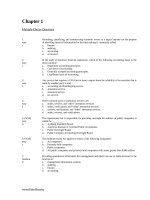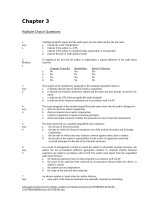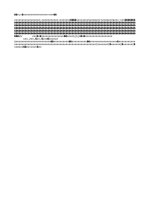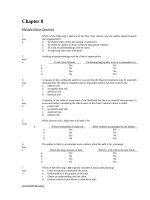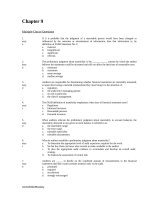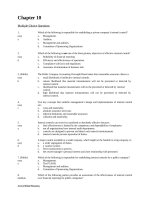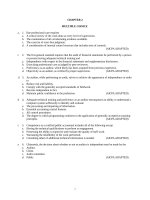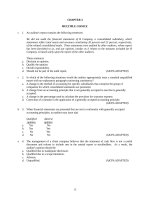Test bank auditing and assurance principles 5e by richiutte ch5
Bạn đang xem bản rút gọn của tài liệu. Xem và tải ngay bản đầy đủ của tài liệu tại đây (40.77 KB, 5 trang )
CHAPTER 5
MULTIPLE CHOICE
c
1. Client strategy templates provide a means for an auditor to
a.
b.
c.
d.
Acquire, evaluate, and document evidence.
Focus on transactions likely to affect audit risk.
Compile the strategies and characteristics of an entity.
Distinguish between engagement risk and audit risk.
a
2. The U.S. market for health care services has experienced a number of cost-containment
initiatives, including
a. Generic substitution.
b. Exclusivity periods.
c. Backorders.
d. Patent abatement.
b
3.
a.
b.
c.
d.
Balanced scorecards provide a means for an auditor to
Evaluate an entity’s profitability, liquidity, and solvency.
Compile data about an entity’s financial, customer, business, and learning perspectives.
Identify financial ratios most relevant to an entity.
Establish trends.
b
4.
a.
b.
c.
d.
The internal business perspective of a balanced scorecard measures all of the following except
Product development.
Productivity.
Core competencies.
Quality.
d
5.
Prior to the acceptance of an audit engagement with a client who has terminated the services of
the predecessor auditor, the CPA should
Contact the predecessor auditor without advising the prospective client and request a complete
report of the circumstance leading to the termination with the understanding that all information
disclosed will be kept confidential.
Accept the engagement without contacting the predecessor auditor since the CPA can include
audit procedures to verify the reason given by the client for the termination.
Not communicate with the predecessor auditor because this would in effect be asking the auditor
to violate the confidential relationship between auditor and client.
Advise the client of the intention to contact the predecessor auditor and request permission for the
contact.
(AICPA ADAPTED)
a.
b.
c.
d.
a
6. Early appointment of the auditor enables preliminary work to be performed by the auditor, which
benefits the client in that it permits the examination to be performed in
a. A more efficient manner.
b. A more thorough manner.
c. Accordance with quality control standards.
d. Accordance with generally accepted auditing standards.
(AICPA ADAPTED)
31
d
7. Which of the following should an auditor obtain from the predecessor auditor prior to accepting
an audit engagement?
a. Analysis of balance sheet accounts.
b. Analysis of income statement accounts.
c. All matters of continuing accounting significance.
d. Facts that might bear on the integrity of management.
(AICPA ADAPTED)
d
8. A difference of opinion over accounting and auditing matters relative to a particular phase of the
audit arises between an assistant auditor and the auditor responsible for the engagement. After
appropriate consultation, the assistant auditor asks to be disassociated from the resolution of the
matter. The working papers would probably be
Silent on the matter since it is an internal matter of the firm.
Expanded to note that the assistant auditor is completely disassociated from responsibility for the auditor's
opinion.
Expanded to document the additional work required since all disagreements of this type will require
expanded substantive testing.
Expanded to document the assistant auditor's position and how the difference of opinion was resolved.
(AICPA ADAPTED)
d 9. Which of the following situations would most likely require special audit planning by the auditor?
Some items of factory and office equipment do not bear identification numbers.
Depreciation methods used on the client's tax return differ from those used on the books.
Assets costing less than $500 are expensed even though the expected life exceeds one year.
Inventory comprises precious stones.
(AICPA ADAPTED)
b
10. What is the responsibility of a successor auditor to communicate with the predecessor auditor in
connection with a prospective new client?
The successor auditor has no responsibility to contact the predecessor auditor.
The successor auditor should obtain permission from the prospective client to contact the predecessor
auditor.
The successor auditor should contact the predecessor auditor if the client authorizes contact.
The successor auditor need not contact the predecessor if the successor is aware of all available relevant
facts.
(AICPA ADAPTED)
d 11. The auditor will not ordinarily initiate discussion with the audit committee concerning the
Extent to which the work of internal auditors will influence the scope of the examination.
Extent to which change in the company's organization will influence the scope of the examination.
Details of potential problems the auditor believes might cause a qualified opinion.
Details of the procedures the auditor intends to apply.
(AICPA ADAPTED)
d
12. With respect to the auditor's planning of a year-end examination, which of the following
statements is always true?
a. An engagement should not be accepted after the fiscal year-end.
b. An inventory count must be observed at the balance sheet date.
c. The client's audit committee should not be told of the specific audit procedures that will be
performed.
d. It is an acceptable practice to carry out substantial parts of the examination at interim dates.
(AICPA ADAPTED)
32
d
13. In planning an audit engagement, which of the following affects the independent auditor's
judgment as to the quantity, type, and content of working papers?
a. The estimated occurrence rate of attributes.
b. The preliminary evaluations based on substantive testing.
c. The content of the client's representation letter.
d. The anticipated nature of the auditor's report.
(AICPA ADAPTED)
d
14. In pursuing its quality control objectives with respect to acceptance of a client, a CPA firm is not
likely to
a. Make inquiries of the proposed client's legal counsel.
b. Review financial statements of the proposed client.
c. Make inquiries of previous auditors.
d. Review the personnel practices of the proposed client.
(AICPA ADAPTED)
a
15. The independent auditor's plan for an audit in accordance with generally accepted auditing
standards is influenced by the possibility of material errors. The auditor will therefore conduct
the examination with an attitude of
Professional skepticism.
Subjective mistrust.
Objective indifference.
Professional responsiveness.
(AICPA ADAPTED)
d
16. In using the work of a specialist, an understanding should exist among the auditor, the client, and
the specialist as to the nature of the work to be performed by the specialist. Preferably, the
understanding should be documented and would include all of the following except
The objectives and scope of the specialist's work.
The specialist's representations as to her or his relationship, if any, to the client.
The specialist's understanding of the auditor's corroborative use of the specialist's findings in relation to
the representations in the financial statements.
A statement that the methods or assumptions to be used are not inconsistent with those used by the client.
(AICPA ADAPTED)
SHORT ANSWER
1. Explain the difference between errors and fraud.
Answer:
Errors are unintentional misstatements or omission in financial statements whereas fraud arises
from fraudulent financial reporting and from misappropriation of assets.
2. Explain what is meant by professional skepticism.
Answer:
Professional skepticism is an attitude which recognizes that managements may have incentive to
intentionally misstate amounts or disclosures in the financial statements.
33
3. Explain the importance of substantive tests in the audit process.
Answer:
The purpose of substantive tests is to detect material misstatements that had not been prevented or
detected by the entity’s internal controls. The nature, timing, and extent of substantive tests map
to the assessed level of detection risk and will vary depending on the client’s industry.
4. What is a deliverable and what is its purpose?
Answer:
In an assurance service to assess the relevance of benchmarking measures, the deliverable is an
open-ended, nonstandardized report to senior management and the board of directors. The report
could conclude whether management’s performance measures are relevant to the company’s goals
and mission, and whether management’s information system offer reliable measures.
5. During the course of the financial statement audit, the auditor may receive written or oral
representations from management. With such representations, what is a requirement of SAS No.
85?
Answer:
SAS No. 85, “Client Representations,” requires that an auditor obtain written representation from
management in the form of a management representation letter. The representation an auditor
obtains from management depends on the circumstances of the engagement but, at a minimum,
management is required to represent that the financial statements are presented fairly in
conformity with GAAP.
PROBLEMS
1. Please explain the steps the auditor must take if:
a. The auditor detects fraud, but has determined that the effect on the financial statements
could not be material.
b. The auditor detects a material fraud or has been unable to evaluate materiality.
Answer:
In the case of fraud that has been determined not material an auditor must:
Refer the matter to an appropriate level of management that is at least one level above those involved, and
Be satisfied that, given the position of the likely perpetrator, the fraud has no implications for other
aspects of the audit or that those implications have been adequately considered.
In the case of fraud that has been determined to be material or that the auditor has been
unable to evaluate the materiality, the auditor must:
Consider the implications for other aspects of the audit,
Discuss the matter and the approach to further investigation with an appropriate level of management that
is at least one level above those involved,
Attempt to obtain evidence to determine whether in fact material frauds exist and, if so, their effect, and
If appropriate, suggest that the client consult with legal counsel about questions of law.
2. To emphasize management’s responsibility for audit adjustments, the Auditing Standards Board
issued SAS No. 88, “Audit Adjustments.” Explain the purpose and requirements of this standard
as it pertains to management.
34
Answer:
In the planning stage of the engagement, management’s engagement letter includes a
statement that management understands their responsibility to record materialproposed adjusting journal entries and to confirm in a representation letter at the end
of the engagement that unrecorded adjusting journal entries are immaterial, both
individually and in aggregate.
At year-end, management is responsible to confirm in a representation letter the
responsibility represented in the engagement letter. The proposed but unrecorded
adjusting journal entries summarized in the letter are immaterial, both individually
and in aggregate.
At year-end, the auditor informs the audit committee about management’s
representation, usually at a regularly scheduled audit committee meeting.
35
